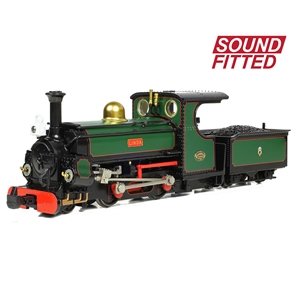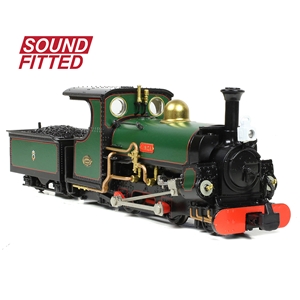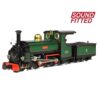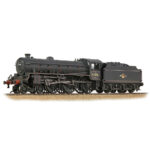The new Bachmann Narrow Gauge model of ‘Linda’ brings the story of this Mainline Hunslet locomotive right up to date, with models of ‘Linda’ as operating on the Penrhyn Quarry Railway and in her early-Ffestiniog Railway condition already produced by Bachmann in OO9 scale. Completing the story is this latest release, depicting ‘Linda’ in her current condition as a 2-4-0 Saddle Tank with Tender (2-4-0STT), carrying the vibrant Ffestiniog Railway Green livery and complete with SOUND FITTED.
This model was first announced during the Ffestiniog Railway’s Bygones Weekend. ‘Linda’ (and sister locomotive ‘Blanche’) have called the Ffestiniog Railway home since 1963, and we would like thank the railway for the support and advice they have given so generously during the development of these Bachmann Narrow Gauge models.
Originally built as a 0-4-0ST for the Penrhyn Quarry Railway, ‘Linda’ was purchased by the Ffestiniog Railway in 1963 and underwent conversion to left-hand drive, was fitted with a tender and had her cab profile modified, before being rebuilt as a 2-4-0STT in 1970, during which she was also converted to oil firing. Converted back to coal firing in 2013, this Bachmann Narrow Gauge model depicts ‘Linda’ in the condition she ran from 2013 until 2021, before being taken out of service for overhaul.
These small but mighty models feature a diecast metal saddle tank, cylinder block, frames and footplate; coupled with a precision moulded cab, smokebox and other separate detail components to produce a model that is strong and robust yet intricately detailed. The cab interior is a work of art and through the firebox hole firebox lighting is fitted which operates on both analogue and DCC. Talking of DCC, with SOUND FITTED this model can be enjoyed on both DCC and Analogue Control straight out of the box, providing realistic sounds for added enjoyment.
- Bachmann Narrow Gauge OO9 Scale
- Era 9
- Ffestiniog Railway Lined Green livery
- Named ‘Linda’
- Etched Name Plates and Works Plates included
- SOUND FITTED – Fitted with a Zimo MX659N18 DCC Sound Decoder – See below for the function list
- Length 115mm
BACHMANN NARROW GAUGE MAINLINE HUNSLET SPECIFICATION
DETAIL VARIATIONS SPECIFIC TO THIS MODEL
- 2-4-0 Wheel Formation
- Welded Saddle Tank
- Open Cab with Tender
- Reprofiled Cab Roof
- Vacuum Brakes Fitted
- Modified Injector Pipework
- Square Sand Pots mounted on the front of the Saddle Tank
- Single Piece Smokebox Handrail
- Left-hand Drive
- Slide Valve Cylinders
- Original Chimney
- Sliding Firebox Door
MECHANISM:
- Coreless motor with flywheel
- Electrical pickup from all driving and tender wheels
- Separate metal bearings fitted to each axle (excluding front pony wheels)
- Diecast metal chassis block
- 9mm (OO9 narrow gauge) wheels to NEM310 standards with authentic profile and detailing
- Coupling pockets to NEM355 standards, into which a standard OO9 coupling hook assembly is fitted (hook and loop coupling also supplied for optional fitting)
- Designed to operate on curves of first radius (228.6mm) or greater
DETAILING:
- Diecast metal cylinder block, frames, footplate and saddle tank
- Precision moulded plastic smokebox and cab
- Highly detailed and decorated cab interior including separately fitted regulator, reverser leaver, handbrake, and gauge frames and hinged firebox door which can be posed open/closed
- Hinged fall-plate between locomotive and tender
- Separately applied details including reverser, injectors, handrails, smokebox dart, whistle and tool brackets (where applicable)
- Each model supplied with a set of authentically decorated etched name plates and works plates
Lighting:
- Firebox Glow (on analogue) / Firebox Glow & Flicker (on DCC or when SOUND FITTED models are used on analogue)
DCC:
- Next18 DCC decoder interface
SOUND:
- Speaker installed in all models for optimum sound reproduction
- Zimo MX659N18 DCC Sound Decoder fitted to SOUND FITTED versions
- Sound files produced specifically for the Bachmann Narrow Gauge Mainline Hunslet using recordings from real locomotives
- SOUND FITTED models operate on DCC and Analogue control as supplied
LIVERY APPLICATION:
- Authentic liveries applied to all models
- Multiple paint applications employed on each model
- Logos, numerals and text added as appropriate using multi-stage tampo printing incorporating authentic typefaces, logos and colours
SOUNDS
F1 – Sound – On/Off
F2 – Brake
F3 – Cylinder Drain Cocks
F4 – Bell Whistle (Speed Related)
F5 – Reverser
F6 – On – Firebox Door Open / Off – Firebox Door Closed
F7 – Coal Shovelling (only with F6 On)
F8 – Blower
F9 – Flange Squeal (Speed Related)
F10 – Speed Lock
F11 – Hand Brake (Functional)
F12 – Water Tank Filling
F13 – Coupling Clank
F14 – Light Engine Mode
F15 – Fade All Sounds
F16 – Guard’s Whistle
F17 – Enable Auto Wagon Buffering
F18 – Injector
F19 – Alternative Whistle (Speed Related)
F20 – Shunting Mode
F21 – Safety Valves Lifted
F22 – ‘Clear my side’
F23 – ‘Red light ahead’
F24 – ‘Coal on the fire’
F25 – Volume Down
F26 – Volume Up
Analogue Users: Please note that normal load running sounds, acceleration steam chuff sounds and any other automatic and randomised sounds will also operate when this model is used on analogue control (DC) straight from the box!
MAINLINE HUNSLET HISTORY
Most famous for their operation on the North Wales narrow gauge railways, the first Mainline Hunslet was built in 1882 by the Hunslet Engine Company of Leeds for the Penrhyn Quarry Railway. Named ‘Charles’, the locomotive’s somewhat unconventional appearance, with steeply inclined cylinders and connecting rods located on the inside of the coupling rods, would be repeated eleven years later when ‘Linda’ and ‘Blanche’ were constructed. Known affectionately by many enthusiasts as ‘the Ladies’, they were ostensibly built to the same 0-4-0 saddle tank design as ‘Charles’, although the ‘Ladies’ did incorporate some differences when compared to their elder. They had larger fire grates for one, round spectacle glasses in the front cab sheet rather than the square ones fitted to ‘Charles’ for another, and were also fractionally longer.
Penrhyn Quarry was the largest slate quarry in the world at the end of the nineteenth century and the trio of Hunslets spent their days hauling slate trains over the Penrhyn main line from the vast quarry complex at Coed-y-Parc, near Bethesda, to Port Penrhyn, just a stone’s throw from Bangor on the North Wales coast. Here, slate products were transferred to standard gauge railway wagons or ships for onward transport around the UK and further afield. Whilst smaller locomotive such as the Quarry Hunslets were used to work the quarry’s internal railways, the larger, more powerful Mainline Hunslets worked the full trains from the quarry down to Port Penrhyn and brought the empty wagons back again – similar duties to those for which the Ffestiniog Railway employed the famous Double Fairlies.
During their working lives the three locomotives underwent several changes, all gained full-height rear cab sheets, replacing the original half-height sheets, welded tanks were fitted in place of the original rivetted versions and various sandbox arrangements were seen, amongst other improvements during their time on the Penrhyn line. By the mid-twentieth century traffic on the Penrhyn Quarry Railway was in decline and in 1962 the last trains ran. ‘Charles’ had already been retired in in the mid-1950s, but the Ladies worked on until the very end.
Offered for sale upon closure of the railway, ‘Linda’ was quickly loaned to the Ffestiniog Railway, arriving there only three days after hauling her last train on the Penrhyn Quarry Railway. In 1963 ‘Linda’ was purchased by the Ffestiniog Railway and ‘Blanche’ too was acquired in the same year, arriving at the railway in December 1963. Both Ladies have been modified by the Ffestiniog Railway since their acquisition, most notably with the fitting of front pony wheels and tenders, becoming 2-4-0STTs (saddle tank tender engines), and their conversion to left hand drive.
‘Linda’ was rebuilt as a 2-4-0STT in 1970 and was converted to oil firing in the same year in an effort to reduce the chances of lineside fires. In 1985 she was rebuilt again, this time with a gas-producer coal firing system, Lempor exhaust and stovepipe chimney. The locomotive reverted to oil firing the following year but retained the stovepipe chimney. During an overhaul in 1990, ‘Linda’ lost her green paintwork and was outshopped instead in Midnight Blue livery, remaining in this condition until the mid-1990s before being repainted into Penrhyn lined black livery.
Running briefly as a tank locomotive during 1996, ‘Linda’ remained in Penrhyn livery until withdrawal for overhaul in 2004. This was not completed until 2011 when ‘Linda’ returned to traffic with an original pattern chimney re-instated. Outshopped again in black, after a brief period running as a tank locomotive ‘Linda’ was reattached to her tender and painted into the lined green livery we know today. In 2013 she reverted back to coal firing, and it is in this condition that ‘Linda’ has remained in service until 2021 when she was withdrawn for overhaul.
With 2023 marking 60 years since the pair were brought by the Ffestiniog Railway, they are unquestionably two of the most useful engines in the railway’s fleet and are as popular as ever with visitors, staff and volunteers alike.
‘Charles’ was also offered for sale, but with the boiler condemned, the Ffestiniog Railway declined. Instead, ‘Charles’ was loaned to the National Trust and is now displayed at Penrhyn Castle – once the family home of the owners of Penrhyn Quarry.





















